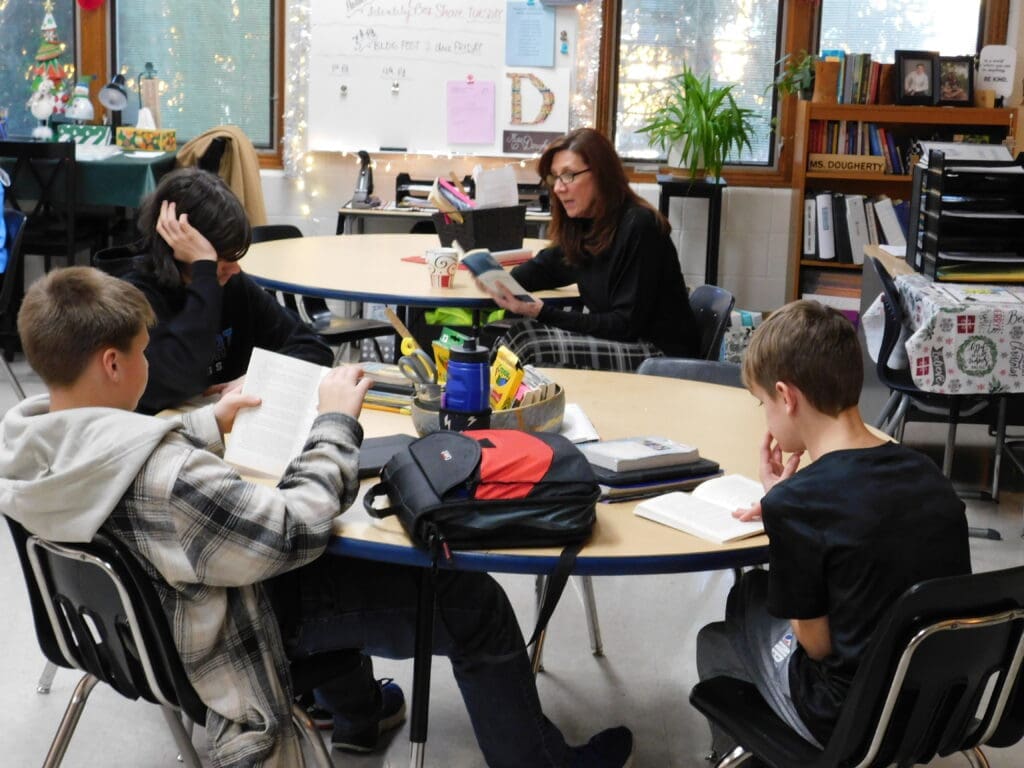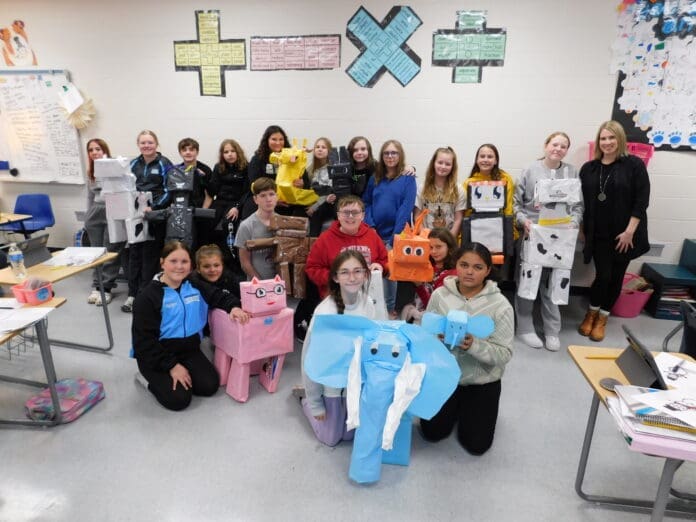BRIDGEPORT – Starting this school year, Bridgeport Middle School students got some added dimensions to their education through new enrichment classes, and the explorations of history, other cultures and hands-on application of math skills are carrying forward into the new semester.
Bridgeport Exempted Village School District has modified its schedule by adding five minutes to the end of the day, altering other class times from 43 minutes to 40 minutes, and reducing the time between classes for an overall yearly increase of 39 class hours. High schoolers are using this time for study, intervention, and completion of assignments, and enrichment classes are now offered at the middle school.
Teachers are making the most of the opportunity.
Lori Dougherty went in-depth about a grim period of history with her eighth graders last semester, and she is teaching seventh graders this semester.
“We were given the option of choosing the subject to teach, and I decided to do a Holocaust study through literature.”
Material includes the realistic fiction “The Boy in the Striped Pajamas” by John Boyne, and “Night,” a memoir by Holocaust survivor Elie Wiesel. The class reads and discusses the books and watches a film of “The Boy in the Striped Pajamas.”
“A lot of the kids knew a lot about the Holocaust, but then there was a lot of stuff that they didn’t know,” she said. “Many of them are shocked, surprised, questioning how something like this was able to happen.”
Dougherty said both books contain some intense material. She spoke with the eighth-grade class prior to beginning, and the students said they could handle it.
“I may have to alter a few things for the seventh grade, just because it is heavy.”

Assignments relate to challenges the narrators face in “The Boy in the Striped Pajamas” and “Night,” such as Wiesel’s self-discovery and the different roles people play.
“A big part of the book is Elie Wiesel’s search for his own identity as a Jew, a Holocaust survivor.”
Crystal Twarog’s class is problem-solving, where she shows her sixth graders ways they can put their math lessons to practical use.
“It gives me a chance to take a lot of concepts that we learned in math and dig a little deeper and actually apply it to a real-world situation.”
Assignments include using their iPads to calculate surface area and volume and using those skills to create three-dimensional boxes using recycled material, then putting them together to make different animals.
“They had to take the surface area of every box that made up that animal, then they calculated the total surface area and the total volume of that animal,” she said. “I think they really enjoyed it.”
Twarog said calculating surface area applies to tasks such as painting and laying carpet. Other assignments last semester included using decimals and percents to calculate discounts and tax for Christmas shopping lists. She will also have them work on surveys and graphs and how they are applied.
“We get to do more of a hands-on and project-based learning activities,” she said. “We don’t always get time to do that in our regular class.”
Christine Malone taught seventh graders introduction to Spanish and has moved on to eighth graders this semester.
“This is the first time they’ve ever been in a classroom setting where they’ve heard the Spanish language, and I think it’s went really, really well,” she said of the seventh graders. “They’re always excited to learn new vocabulary and to participate, and at the beginning of the year we talked about the benefits of learning a different language.”
A lover of travel, Malone saw the enrichment classes as a chance to introduce her students to another culture. She said familiarity with another language could also benefit them in later education and open job opportunities.
She considers what her students would need if they found themselves in a Spanish speaking country. The kiddos can be heard speaking and listening to Spanish and looking at English words that have a Spanish origin. Assignments include creating Christmas cards with Spanish greetings. The lessons have also helped students in their English classes.
“It’s been beyond positive. The participation in class is amazing,” she said. “I’ve really enjoyed having the opportunity to teach this class and it’s been amazing with the positive reception that we’ve had.”
Dr. Deborah Romick-Glynn’s fifth graders are exploring some chilling mysteries in her haunted history class. The entire fifth grade has the option to attend the 12-week course in three different groups throughout the school year.
Romick-Glynn covers events such as the cannibalism at Jamestown, Virginia, during “The Starving Time” in the winter of 1609-1610. The material offers a chance for creative teaching. She wrote a ghost story to accompany the lesson of the Starving Time and students were asked to consider what they might do in such a situation. They also investigate different theories of the lost colony of Roanoke. They must put forward a theory and support it, and create a story, artist’s rendering or other expression.
“They become detectives.”
At other times, the students will study stories of Revolutionary War ghosts in Ohio and spirits rumored to linger from Civil War battlefield hospitals.
“All of the lessons and activities are centered around historical events that are from American history,” she said.
“I’ve always wanted to design and teach a haunted history class, because there are so many things that are real, that are horrific,” she said, adding she saw a chance to instill a passion to learn about the past. “The kids seem to love it.”
Romick-Glynn sends letters to parents letting them know that the material is age appropriate and that the lessons are taught in a historical way. No parents have opted their children out of the class.
“I am very blessed to be allowed to do this. I’m very thankful to our district and to Middle School Principal Anne Haverty Lawson for letting me do this.”


